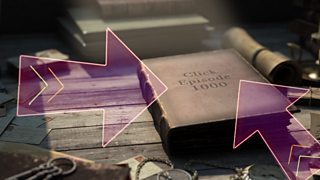- Try
- Rate
- Share
How did you rate this?

The Inside Story
We spoke to Jake Berger, Programme Manager, Digital Public Space to find out more.
In May 2016 we launched the first version of BBC RemArc - the BBC Reminiscence Archive - which is designed to trigger memories and reminiscences in people with dementia. You can read the original Inside Story at the end of this article, which will give you some background information about the project.
User Research
Following the launch, we wanted to see how RemArc worked in practice, so, supported by the Alzheimer’s Society, I visited a number of groups of people with dementia. Over the summer of 2016, I spent time with 53 people with dementia, letting them try out RemArc, listening to their ideas, observing their responses, and noting down their ideas and suggestions.
This was a hugely valuable and informative process: it is impossible to know how any product or service is *actually* going to be received by its intended users, whether it does what you hoped it would, and whether people respond to it and interact with it as you had expected.
What did we learn?
Firstly, we learned that using archive material to trigger memories and reminiscences really does work. During the sessions many memories were triggered, sparking great reminiscences and conversations, and seemingly enhancing the relationships between people with dementia, others in the groups and their carers. It was also notable that a large number of people said that they remembered more about their past than they thought they would.
Secondly, we learned that the online, tablet based approach and the interaction design we used seems to work well for people with dementia. However, several improvements were suggested, which are outlined in more detail later in this article.
Thirdly, we learned that reminiscence can be very enjoyable, engaging and, quite simply, fun. During most of the testing sessions, which were supposed to last around 20 minutes, I had to ask the groups to return the tablets after an hour, as they were so engaged with RemArc, and having so many great reminiscences!
To illustrate, here are some quotes from the sessions:
‘It takes you back to what you used to do’
‘Makes you realise how much you thought you’d forgotten’
‘We remembered so much about the past yet we are here because we have failing memories’
‘I could sit here all day’
‘It's amazing that this resource is there, forever’
The content
With regards to the selection of content available on RemArc, overall there was no single decade or theme that stood out as most popular, though All of the decade options were used across the test groups, though most frequently chosen decades tended to be 1940s, 1950s and 1960s; and the most frequently selected themes were People, Events, Music, Sport and TV & Radio. A number of people suggested that there should be a Songs category.
What has changed in RemArc 2?
As a direct result of the user research, we have made a number of changes in RemArc 2.
- Nearly every user during the testing said they would like to find out more information about images, video and audio clips featured in RemArc, so we have added an ‘Info’ button in RemArc 2, which when pressed, overlays some information about each item.
- We have increased the font sizes and button sizes across the web app, and we have increased the contrast between background and foreground text and buttons.
- Many users didn’t know that the ‘Home’ button took you back to the RemArc front page, so we have changed this button to say ’Start Again’.
- In RemArc 1, each session loaded a random selection of 25 content items per Theme or Decade. This meant that if the user had looked at the full set of 25 items in a Theme or Decade, they had to refresh their browser to see a new set of content. In practice, users didn’t know that there were more than 25 items, or that they could refresh the browser, so they missed out on seeing the full set of content available. In RemArc 2, we have added a button to load more items after the initial 25 items have been viewed.
Sharing our code, content and data
It was always our intention to open source the RemArc code so that other people can create their own versions of the app for free. You can find the code here, licensed under the Apache 2.0 Software license.
We have also made the RemArc media available for reuse. You can access this media and metadata via the BBC RES API here. The media is licensed for non commercial use (i.e. personal, educational or research use) under the RemArc License and the metadata is licensed under the OGL2 License
If you want to find out more, please contact jake.berger@bbc.co.uk
Below is the original ‘Inside Story’ article from when RemArc fisrt launched in May 2016
We wanted to achieve a number of things with RemArc.
Firstly, and most importantly, to use BBC archive material to benefit those of our audience members who have dementia, their families and their carers. We hope that amongst the 1500 items from our archives that are available on RemArc, there will be something that triggers a reminiscence for everyone. Having learned much about dementia and the benefits of reminiscence work from Dr. Norman Alm from the University Of Dundee, we were confident that the BBC’s archives could be put to good use in this area. Norman and colleagues from Dundee and the University of St Andrews have spent many years working in the area and we benefited hugely from his knowledge, experience and passion.
Secondly, we wanted to demonstrate that it is not only the famous shows and well known historical events captured in the BBC’s archives that are of interest and are of value - sometimes the most obscure or minor detail, say captured in a photograph from the 1940’s, can mean something significant to *someone* out there.
Thirdly, we wanted to make sure that our work can be of benefit to the greatest number of people. To that end, we will be making the RemArc software available for free under an open source license, so that people can build their own reminiscence archives, either in UK or reversion RemArc with new languages for use abroad. We will also make the archive material featured in RemArc available for personal and educational use.
We will be testing RemArc, supported by Alzheimer’s Society and Alzheimer’s Scotland, but in addition to this more formal research, we’d love people who use RemArc to tell us what they think of it: Did you find that it triggered reminiscences? Did you find it easy to use? What sort of material was most interesting and effective? Do you have any suggestions for improvements?
To try it, simply select a Theme (such as Sport, Events etc.) or a Decade (1930s, 1940s etc.) and choose whether you wish to have Image, Audio or Video content. The results are randomised each visit, however items can be 'favourited' to return to later.
Each RemArc session displays a limited number of images, audio clips or video clips, so if you find that you’ve seen all of the material in a particular category and want to see more, just refresh your browser and you’ll see a completely new set.



